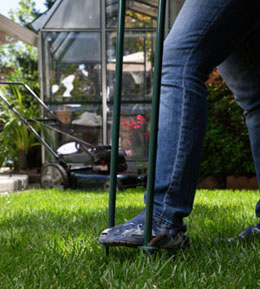Lawn aeration increases the amount of oxygen that is made available to the root system of turf grasses. It is carried out with the help of lawn aerators during active growing seasons. Read to learn more about lawn aeration - the how, the why, and the when.

Lawns are the basic components of almost all landscapes. They not only provide a cooling effect to the eyes, but also serve as a tool in conserving the environment. Nevertheless, it is of prime importance that you follow certain maintenance tips, which would give them a healthy and lustrous green appearance. Lawn grasses or turf grasses left on their own may outgrow and be susceptible to diseases and infestations. A diseased lawn usually shows dry spots that are brown in color. Some basic tips include proper watering, mowing, aeration, weed control, mulching, dethatching, fertilizer application, and monitoring of soil conditions.
Lawn aeration involves increasing the amount of oxygen in the soil. It reduces soil compactness, breaks accumulated thatch, and increases water infiltration. As oxygen is made available to the root system, the growth and development of roots shoots up, which is necessary for the assimilation of plant nutrients from the soil. Another advantage is increase in water absorption from the soil. Overall, soil aeration helps in maintaining a healthy lawn. It can be achieved either by creating holes in the lawn with the help of a metal rod or removing a core of the soil.
A lawn aerator is a basic gardening tool, designed specifically for aerating the soil. Speaking about the mode of operation, there are both manual and power aerators. In the former case, the tool has 2-4 hollow pipes for removing the plugs of soil, whereas in the latter type, mechanical devices are used for extracting the cores of soil at specific intervals. Such devices provide uniform aeration in the lawn, i.e., ½ - ¾ inch diameter soil cores are removed from a depth of 1-6 inches at about 2-6 inch space between two holes. Power aerators are usually bigger in size than a manual aerator.
Depending upon the method of soil aeration, there are three types of lawn aerators, namely, spike aerators, core aerators, and solid tine aerators. Spike aerators have several metallic spikes that are used for punching the lawn, while core aerators consist of hollow spikes for the removal of soil plugs. Solid tine aerators, as the name suggests, are solid rods used for creating deep holes (about 25 inch) in the lawn. Among these aerators, core type is best suited for aerating a compact soil.
Best Time for Aerating a Lawn
Lawn aeration is recommended after establishment of the turfgrass, preferably one year after the plantation of lawn grasses. The standard frequency varies based on the growing conditions. For example, lawns situated in heavy traffic areas and those with a compact soil should be aerated 2-3 times per year. On an average, aeration should be done at least once in a year for all types of lawns.
Since lawn aeration affects about 25 percent of the total lawn area, it should be carried out during active growing season. The best time is during the spring and fall. As the turf grasses grow vigorously during these months, they will recover quickly after aeration. Lawn aeration during summer months is not recommended, as the turf grasses are less active in this period. If aerated during summer, it may lead to increase in stress conditions for the lawn grasses, which may cause thinning and weed growth.
For better results, water the lawn properly one day prior to aeration. After it has been aerated, add peat moss or farmyard compost to fill the holes. Compost should be spread evenly, if possible fill the holes with the back of a garden rake. Fertilize the aerated lawn after two weeks of aeration and follow basic lawn maintenance. With proper aeration and lawn care tips, the beauty and appearance of turfgrass can be maintained easily.






 Lawns are the basic components of almost all landscapes. They not only provide a cooling effect to the eyes, but also serve as a tool in conserving the environment. Nevertheless, it is of prime importance that you follow certain maintenance tips, which would give them a healthy and lustrous green appearance. Lawn grasses or turf grasses left on their own may outgrow and be susceptible to diseases and infestations. A diseased lawn usually shows dry spots that are brown in color. Some basic tips include proper watering, mowing, aeration, weed control, mulching, dethatching, fertilizer application, and monitoring of soil conditions.
Lawns are the basic components of almost all landscapes. They not only provide a cooling effect to the eyes, but also serve as a tool in conserving the environment. Nevertheless, it is of prime importance that you follow certain maintenance tips, which would give them a healthy and lustrous green appearance. Lawn grasses or turf grasses left on their own may outgrow and be susceptible to diseases and infestations. A diseased lawn usually shows dry spots that are brown in color. Some basic tips include proper watering, mowing, aeration, weed control, mulching, dethatching, fertilizer application, and monitoring of soil conditions.